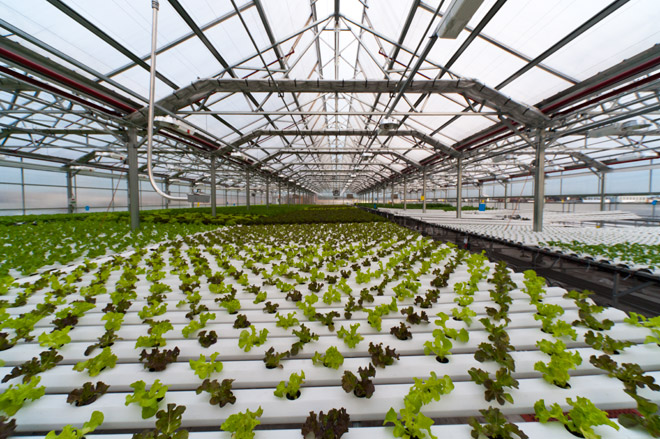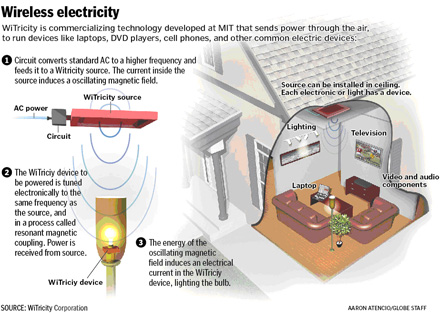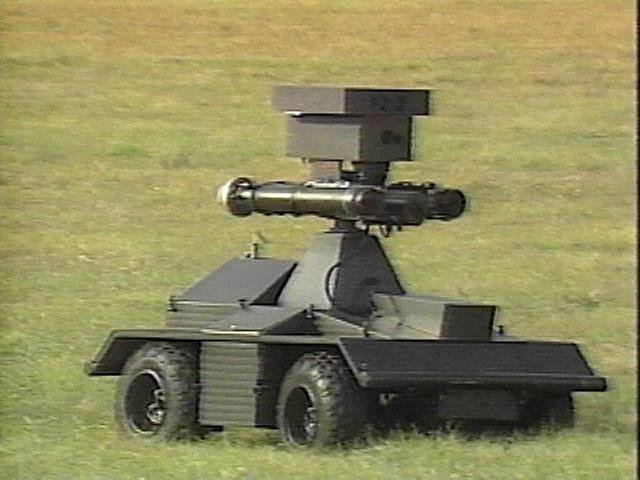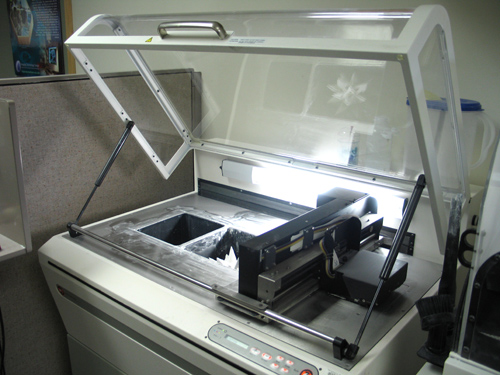10 Exciting Technologies that Could Change the Entire World
Suggested by SMSWe’ve all seen how computers, cell phones, the internet, and other new technologies have changed our lives and revolutionized business and industry. Here are ten up-and-coming technologies with the potential to make even greater changes.
10. 3-D Printing
This could potentially be the most disruptive technology introduced since the personal computer. A 3-D printer is literally a factory in a box; a person puts in raw material, pushes a button, and the box makes an object. Today’s 3-D printers make plastic models or metal parts for machines. They’re called printers because they make three dimensional objects the way printers put images on paper. In the future, when you go to the garage, instead of ordering parts, the mechanic could look them up online, then download the designs into a 3-D printer that could make them. Huge numbers of inventors and engineers all over the world are working on 3-D printers. There are plans for printers that make food, clothing, chemicals, and drugs. A pharmacist using a drug printer could manufacture your prescription while you wait. A company named Contour Crafting even has plans to make buildings with 3-D printed components. If 3-D printing works out, the changes it brings could be vast. Instead of factories in China making our clothes and a vast transportation structure, there could be a machine in a shop at the mall that makes clothing. There’s also a dark side to this; for example, how will gun control laws be enforced if anybody can download the plans to an AK-47 and make one using a printer?
9. Maglev

A Maglev Train on the Yamanashi Test Track in Japan
A magnetic levitation, or Maglev train, uses magnetism to literally levitate right above a track. This enables the train to move across the ground at speeds of over 300 miles per hour using minimal energy and few moving parts. That means it provides high speed ground travel at little or no cost. A person using one would be able to travel from Las Vegas to Los Angeles in about an hour. The Transrapid combine from Germany has perfected maglev and built a 19-mile long maglev that carries commuters between Pudong International Airport and the Chinese City of Shanghai. A 10-mile long Maglev commuter line is under construction in Beijing. The Japanese government has given preliminary approval for the Chuo Shinkansen, the world’s first Maglev bullet train, which would travel between Tokyo, Osaka, and Nagoya at speeds of 505 kilometers (313 miles) an hour. Current plans call for service to begin in 2027. Several other maglev lines are planned around the world, including some in the U.S. The effects of Maglev travel could be as disruptive as earlier transportation advances like cars. Maglev could allow a person to live in Altoona, Penn., or Rochester, N.Y. and commute to a job in Manhattan everyday. It could also greatly reduce the cost of shipping and travel. The only thing blocking this technology would be the high cost of building Maglev lines. Several Maglev projects have been proposed in Germany, but cancelled due to costs. Successful lines in Japan and elsewhere could change that.
8. Fuel cells/Energy servers

Clear Edge’s Residential Fuel Cell. This technology is almost in your home
Imagine a future without power lines or an electric power grid. That’s what these advances could promise. Instead of thousands of miles of wire, all the energy needed for your home could be produced by a box in your basement. Other advances could be electric cars that could run for a year or more on a unit. That’s the promise of a fuel cell, a device that converts fuel such as hydrogen, natural gas, or gasoline directly into electricity. The technology has been around for a long time, but it is getting perfected. Big companies like Wal-Mart are now buying devices called Bloom Boxes that employ fuel cells as backup power generators. The gas company in Great Britain is readying home fuel cells that operate on natural gas, these would produce both heat and electricity. A company in the U.S. called Clear Edge Power is promoting a home fuel cell that would serve as a hot water heater and an electric generator that would run on propane or natural gas, and it is being sold online right now. The effects of this technology could be interesting if a large percentage of its former customers unplug from it and start making their own power at home.
7. Hydroponics

The Gotham Greens Hydroponics greenhouse in Brooklyn could be a preview of the factory farm of the future
This is the science of growing plants in water and liquid fertilizer in a greenhouse instead of a farm’s field. This method could produce better fruits and vegetables, and it’s been around a long time since World War II. The only thing that’s prevented its adoption has been the high cost of energy. New technology, some of it interestingly enough developed by illegal marijuana growers, is making it viable again. One advantage such operations have would be lower transportation costs; food could be grown in warehouses and other buildings in large cities and provide vegetables all year long. Another advantage is that hydroponics does not require pesticides or herbicides, so it uses fewer chemicals and is healthier. There is no risk of cancer or other side effects caused by pesticides because none of them are used. It could also be used to grow large amounts of food in areas where extra land is not available or cropland has been exhausted by overfarming. If energy costs are kept down, it would be competitive with food shipped over long distances. Hydroponics is already being tested in the U.S. A company called Gotham Greens is pioneering hydroponics in New York City with a large scale greenhouse in an old bowling alley in Brooklyn. It produces organic lettuce and basil for sale to the city’s restaurants. If energy costs can be kept down, this could be the agriculture of the future. One technology that could do that is cold fusion. If crops can be grown 12 months a year in a climate controlled greenhouse, how will traditional farms compete?
6. Hot Fusion
Hot fusion basically attempts to recreate the process that the sun uses to generate heat and light. Hot fusion would generate vast amounts of heat and could be used to run steam turbines to generate electricity. It could also be used for waste disposal, particularly the burning of hazardous waste. An example of the use of hot fusion would be a plant under the streets of Manhattan that would provide all the heat and electricity the skyscrapers above need and burn up all the garbage they produce without producing any pollution. Governments and big corporations have been working on it for decades with little or no success. A consortium of nations called the ITER is building a demonstration hot fusion plant in France that could prove its feasibility. Currently, its plant is supposed to start making super hot plasma and demonstrate the viability of hot fusion in 2019. Unfortunately, its plans do not call for large scale power generation by hot fusion until the 2030s. The private sector might beat ITER to the market. Several private companies, including General Fusion in Canada and Lawrenceville Plasma Physics in the U.S., are also working on fusion and could beat ITER to the punch. These companies have not achieved success yet, but they have high level support. Bill Gates and Steve Bezos of Amazon are among the wealthy investors who have shelled out money to support their work. If it works, hot fusion could make electricity production cheaper, and it would apparently be safer than traditional nuclear reactors.
5. Wireless Electricity

WiTricity, a Massachusetts company, is developing an energy hotspot that could transmit electricity to all the gadgets in your home
We’re all familiar with the wireless internet in which you can access the web through radio signals. Well, how about wireless electricity in which electronic devices literally pull power out of the air? Instead of extension cords, you would have an electric hotspot that would provide power to your gadgets. In the future, phones could draw power from the cell phone network in the way they draw signals today. Long-term electric cars could draw power from transmitters by the road. Or electricity could be transmitted like microwave signals are today, eliminating the need for an expensive power grid. That’s the promise of wireless electricity, it’s not a new idea. Nikola Tesla, Edison’s great rival and the inventor of the electric grid, tried to develop it in the last century. Companies like Powercast and WiTricity are developing it now. WiTricity uses technology developed at MIT. WiTricity already has light bulbs that can run off radio waves, and is currently working on two applications of the technology, direct wireless power, in which devices will be powered only by wireless, and automatic wireless charging, in which device recharges itself when it gets in a wireless electric hotspot. With this technology, an electric car could recharge itself in a parking lot without being plugged in. WiTricity currently has contracts to work on wireless charging for electric vehicles with companies like Toyota and Mitsubishi. It’s also working on the wireless charging of medical implants, such as pacemakers. The only thing stopping it is the lack of power; if it could be perfected, it could be as big a game changer as Cold Fusion.
4. Robotic Vehicles

Robotic vehicle being developed by U.S. Defense Contractor General Dynamics and the Pentagon’s weird science agency DARPA (the Defense Advanced Research Projects Agency)
Remote-controlled drones and robot planes are already changing the face of warfare and will soon be moving into other fields. Some examples could be buses and taxi cabs that drive themselves. Drones could soon be doing surveillance for the police and covering news stories for TV stations in our cities. Imagine a rental car that drives back to the Avis or Hertz location when you no longer need it. Or delivery trucks without drivers. Another potential development would be pilot-less air shuttles that could pick people up and take them where they want to go. Other examples could be construction machines like bulldozers that run themselves. Or even robot tanks to patrol the battlefield of the future. Smaller robotic vehicles, including robotic fish that actually swim underwater and mini drones that fly like hummingbirds, could have even other uses we are not aware of. These devices could be used for surveillance or to deliver bombs in warfare. More peaceful uses could be robotic street sweepers to keep our cities clean or robotic lawnmowers in public parks.
3. Biological Therapy

An artist’s representation of how biological therapy fights cancer on a molecular level
Also called vaccine therapy, biotherapy or biological response modifier therapy is an approach that literally reprograms the human immune system to fight disease and its symptoms. It does this with substances made by the body itself, rather than drugs. The immune system is reprogrammed by adding biological modifier substances that change the operation of cells. Some of these substances can program white blood cells to destroy cancer cells or destroy cancer cells on a molecular level. They can even alter the growth patterns of cancer cells so they operate like healthy tissue. Today it’s being used as a cancer treatment, but in the future, it could be used as a treatment for other diseases. Some biological therapies can counteract the symptoms of cancer. It is possible that someday biological therapies that could counteract or even reverse some of the symptoms of aging could be developed. New treatments are being developed, include cancer vaccines. Doctors at the Hassadah University in Israel are even testing a new cancer vaccine that could keep 90 percent of cancers from coming back. The vaccine is being developed by a company called Vaxil Bio Therapeutics. Future developments in this field could be vaccines for allergies, infections, viruses (including AIDS and the common cold), and the effects of diseases such as Parkinson’s and Alzheimer’s.
2. Cold fusion, or Low Energy Nuclear Reaction (LENR)

What a Cold Fusion Powered Hot Heater/Boiler Might Look Like
This technology would give the world an almost limitless source of energy that would not produce greenhouse gases or dangerous radiation. This technology could end the use of fossil fuels and eliminate the threat of global warming. The idea behind this technology is to create a low-powered nuclear reaction by using an electrochemical process. The reaction would be small enough to be contained in a device about the size of a car engine. Yet, the potential power here would be incredible. A 2009 report from the U.S. Defense Intelligence Agency estimates that nuclear fusion could release 10 million times more energy per unit mass than present day fuels like gasoline. Uses for this could be a car that could run for years without refueling or a truck or a locomotive that could cross North America without refueling. This idea has been around since the 1920s and it is generally dismissed by mainstream science, but in 1989, distinguished scientists Marin Fleischmann and Stanley Pons claimed to have achieved it. Their claims were refuted, but a number of scientists and inventors have worked on it and achieved some results. Since then, around 10,000 reactions have been created in laboratories, and work to build a working cold fusion generator is well under way. Even though the U.S. Department of Energy dismisses cold fusion, the Pentagon apparently thinks it is possible. The U.S. Navy has also done quite a bit of research into it. Italian inventor Andrea Rossi claims to have a working cold fusion device based on a nickel-hydrogen reaction which he calls an e-cat, or Energy Catalyzer. Currently the e-cat can boil water or produce low pressure steam, and Rossi is selling it as a commercial water heater. One of Rossi’s first customers was reportedly the U.S. Navy. He’s also working on a smaller version for use in the home. Two other companies, Defkalion in Greece and Brillouin Energy Corp in the U.S., also claim to have working cold fusion boilers. Defkalion has announced plans to bring its technology to market next year. Working cold fusion boilers would dramatically lower the cost of heating and a lot of industrial processes, including food production. Among the changes cold fusion could bring would be cars and power plants that do not pollute. It could also put a device in your basement that could produce all the electricity, hot water, and heat your family needs with a few dollars’ worth of nickel and hydrogen. If that wasn’t enough, it could end the energy crisis and eliminate the causes of the greenhouse effect.
1. Meat without livestock

Pork being grown from stem cells in a Dutch Lab
This game-changing idea is so new and radical, that it does not even have a proper name yet. Terms used for it include “carnaculture,” “cultured meat” and “in-vitro meat.” The idea is a simple one, grow meat in a tank or vat the way yeast is grown. Scientists such as Mark Post, a physiology professor at the Eindhoven University of Technology in the Netherlands, are trying to grow meat from stem cells, but so far, their efforts have not been very successful. Post estimates that it would cost about $250,000 to grow enough meat to make a sausage with his process. People who have tasted Post’s meat have described it as chewy and tasteless. Any commercial application of this process is years away because scientists have not figured out how to produce something that looks like meat. Yet there could be some real benefits from in-vitro meat if it could be perfected. It could help reduce the greenhouse effect because cattle are a major generator of greenhouse gases. It would also end the damage livestock grazing does to the land and eliminate the vast amounts of pollution created by big and chicken farming. Another benefit of cultured meat is that cultured fish could provide protein and the overfishing of the oceans. A final benefit would be that the vast amounts of grain now fed to livestock could be used for food for the poor or as the ingredients for biofuels. Carnaculture could also provide meat for future space travelers. These promises have led to the formation of a group of European scientists for the development of cultured meat. It would also end the practice of slaughtering animals for meat, which many people find inhumane. Even if the process could be perfected, there are hurdles, such as people finding the idea disgusting, and it could even be illegal under the U.S. Food and Drug Administration regulations. There’s also the cost, and one of the scientists developing it, Dr. Vladimir Mironov of the Medical University of South Carolina, estimates it would cost $1 billion to develop carnaculture. Yet, he hasn’t been able to get any steady funding for his work. So the future of meat grown in a vat is questionable.











